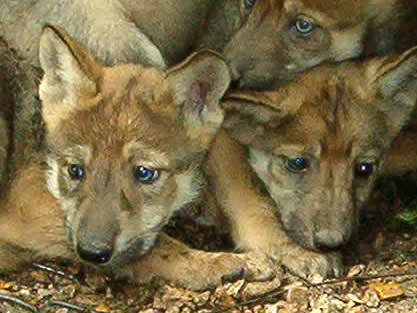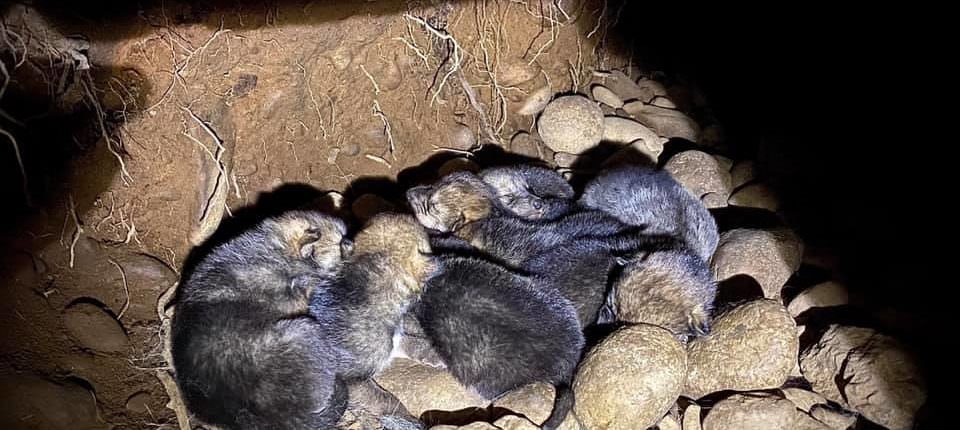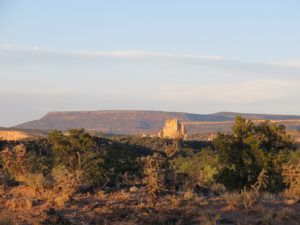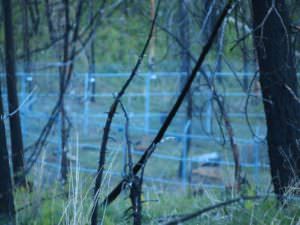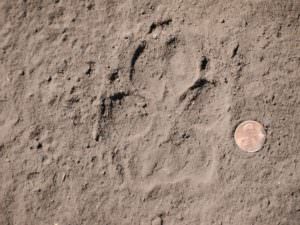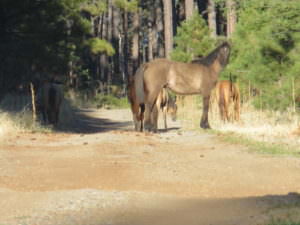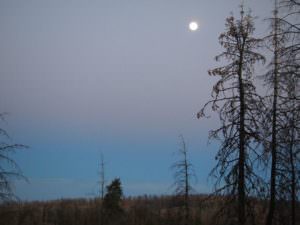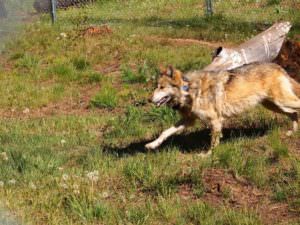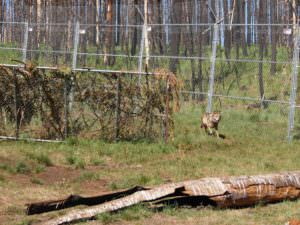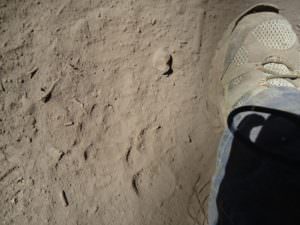Posts
More mouths to feed – Combined Fund Drive, FTE
The cycle of life continues at Wolf Haven, and in the spring, we welcomed Mexican wolf pups to the sanctuary. As partner in a captive breeding program for these critically endangered animals, genetically valuable wolves at our sanctuary are sometimes recommended for breeding. This past season, our Mexican wolf pair F1422 and M1360 (in-house names Vida and Kochi) became the parents of a large litter when Vida whelped in late April.
Wolf Haven Photographer Debuts New Book – ParentMap
Seattle-based fine-art photographer Annie Marie Musselman has photographed the likes of Gloria Steinem and Barack Obama for magazines including Outside, The New Yorker and Elle, but it’s her portraits of animals which resonate the most with people.
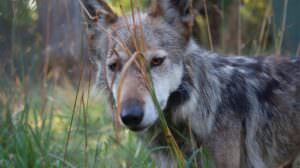
Mexican gray wolf, Annie Marie Musselman photo
Wolf Haven Welcomes Two New Residents – Nisqually Valley News
Wolf Haven International is now home to a record 65 wolves, wolf dogs and coyotes thanks to the addition of two new wolves, Mariah and Hodari.
Helping Save Mexican Wolves – A piece of my heart
Nearly exterminated in the wild during by the 1930s, the Mexican wolf remains one of the most endangered mammals in North America. In May, Wolf Haven’s Director of Animal Care Wendy Spencer assisted in the care & observation of two wolves scheduled for future release. This is Part 12 – the final chapter in an ongoing series of blog posts about her experience in Arizona.
The following morning, all was quiet at the pen. The wolves had opted to sleep in so it would be almost 40 minutes before I saw either one of them and even then, it was brief. We had heard fence fighting all night long until about 2:30 in the morning, so after such a long day and night, they were most likely exhausted. Since this was to be my last morning at the blind and watching the wolves, I said a little prayer and wished them a long, happy and safe life.
Back at camp, it was time to pack up and get on the road to Albuquerque. There was definitely a part of me that did not want to leave, so it was with mixed emotions that I loaded up and said goodbye. As I made towards Alpine, winding along the dry, dusty roads, I was reflected on the week that just passed. It was truly one of the most profound experiences I have ever had and even though it had only been a week, I felt as though I was leaving a little piece of my heart in the Apache forest and with all those who lived there too.
Update: The day I departed, the IFT set traps by the pen in hopes of trapping and collaring the unknown wolf. I received word a few days later that they were indeed able to trap and collar her and she is now identified as F1305. Because the free ranging pair continued to localize around the pen site and appeared prepared to defend their territory if the Coronado pack was released, it was with great disappointment that the IFT decided to return M1051 and F1126 back to captivity. It was by no means an easy decision for the field team but after giving it very careful consideration and evaluating all the pros and cons associated with going forward with the release, it was decided that removing the Coronado pack and returning them to captivity was in the best interest of all the wolves involved. However, just because the pair did not go out this season, they are still slated for release at some point in the next year. The Alpine wilderness has not seen the last of these two.
Helping Save Mexican wolves (#10) – F1305 just wants to have fun
Nearly exterminated in the wild during by the 1930s, the Mexican wolf remains one of the most endangered mammals in North America. In May, Wolf Haven’s Director of Animal Care Wendy Spencer assisted in the care & observation of two wolves scheduled for future release. This is Part 10 of an ongoing series of blog posts about her experience in Arizona.
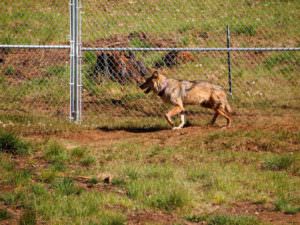 While M1107 would take a time out from fence fighting, F1305 would play on the nearby log pile. She had what would be analogous to a play face and though her tail was straight up, her movements were exaggerated and clumsy as she would often try and invite M1107 to play.
While M1107 would take a time out from fence fighting, F1305 would play on the nearby log pile. She had what would be analogous to a play face and though her tail was straight up, her movements were exaggerated and clumsy as she would often try and invite M1107 to play.
He wanted no part though, as he was clearly in battle mode and focused solely on his rivals. Obviously, there was a conversation that took place between him and the pair because after several minutes of truce (and rest) the three wolves would once again take up their positions at the fence and resume fighting. Meanwhile, the little female would bow and jump around in circles- clearly she did not take this as serious as her new companion did. However, when the fence fighting would increase in intensity, then she would join the fray briefly.
The fence fighting continued for almost 2 hours but just before 7 am, I observed the pair walk over to far side of the pen and curl up in a day bed. M1107 paced back and forth along the fence line as if trying to encourage them to come back, but to no avail. Realizing the pair was not going to take his bait, he headed towards the north side of the pen where he took up post like a sentry. He eventually lay down, but kept a watchful eye. The little female was relentless in her attempts to get M1107 to play- she kept pouncing his head and playfully nipping at his rump, but he ignored her. Perhaps out of sheer boredom, she eventually laid down as well.
Throughout the morning either M1107 or F1226 would initiate a howl but all four would stop what they were doing and join in- it was mesmerizing. Even as I made my way back to camp, I would hear their melodic chorus as it drifted by, carried on the early morning breeze. However, in addition to the howling, I heard bouts of fighting as well and that continued well on into the late morning….. (to be continued)
Helping Save Mexican wolves (#9) – fence fighting between free-ranging & captive wolves
Nearly exterminated in the wild during by the 1930s, the Mexican wolf remains one of the most endangered mammals in North America. In May, Wolf Haven’s Director of Animal Care Wendy Spencer assisted in the care & observation of two wolves scheduled for future release. This is Part 9 of an ongoing series of blog posts about her experience in Arizona.
As I headed to the blind the next morning, a herd of elk cut me off as they made their way across the road. They were huge and beautiful and a picture of sheer grace as they trotted by, except for the baby who was still a bit wobbly.
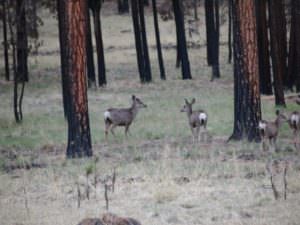 As I crested the ridge, I could hear loud whimpering and whining coming from the pen, amplified by the surrounding hillsides. I was still too far off to see the pen but the sounds continued as I approached. Out of the corner of my eye I saw a group of mule deer slinking past me. Their eyes were as big as saucers and even an uneducated observer like me could tell they were concerned about something. I continued to make my way down to the blind and as the pen came into view I could see movement along the perimeter in front of me.
As I crested the ridge, I could hear loud whimpering and whining coming from the pen, amplified by the surrounding hillsides. I was still too far off to see the pen but the sounds continued as I approached. Out of the corner of my eye I saw a group of mule deer slinking past me. Their eyes were as big as saucers and even an uneducated observer like me could tell they were concerned about something. I continued to make my way down to the blind and as the pen came into view I could see movement along the perimeter in front of me.
It turned out to be an elk darting back and forth along the fence line and M1051 and F1126 were 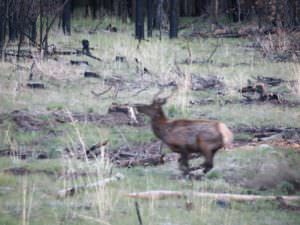 frantically running alongside him. Seconds later I caught a glimpse of something behind the elk but I was still far away and the lighting was poor but the animal looked decidedly canine. I couldn’t believe my eyes! The elk suddenly turned away from the pen and began running up the hill just to the left of the blind and by that time I had made it to the blind and I could make out the distinct coat color and pattern of a Mexican gray wolf as he gave chase to the elk. They both disappeared from view but I could hear them crashing through the woods.
frantically running alongside him. Seconds later I caught a glimpse of something behind the elk but I was still far away and the lighting was poor but the animal looked decidedly canine. I couldn’t believe my eyes! The elk suddenly turned away from the pen and began running up the hill just to the left of the blind and by that time I had made it to the blind and I could make out the distinct coat color and pattern of a Mexican gray wolf as he gave chase to the elk. They both disappeared from view but I could hear them crashing through the woods.
Meanwhile, the wolves in the pen were coming unhinged. They were whimpering and whining and alarm bark/howling- a clear sign that they were agitated and in distress. Even with the naked eye I could see their hackles standing on end from head to tail, with tails held straight up in the air. They quickly bolted to the opposite side of the fence as a wolf came running to the fence and they began fence fighting with each other but this did not look like the same wolf that I watched run after the elk. All of a sudden, the elk came tearing towards the pen again, with the wolf still in tow! The elk found himself caught in between the two free ranging wolves and repeatedly darted back and forth. However, at one point the two wolves took time away from the elk to fence fight with the pair. The fighting became so intense that it was in that moment that the young spike saw his opportunity to get away and I watched as he bolted up the far hill and eventually out of sight.
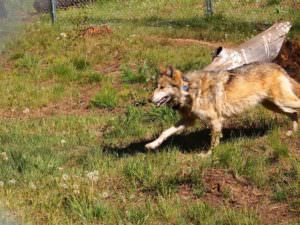 I could not believe what I was seeing! The wolves would periodically take a break from fighting and essential go off to their own corners which allowed me to get good visuals through the scope. I could clearly see a radio collar on one of the free ranging wolves, who presumably was M1107. Even though I didn’t pick up his signal at all during the night, he was the only wolf that had been known to visit the pen site. Also, he was one of just a handful of wolves equipped with a GPS collar and through the scope I could see the telltale antenna. The other wolf looked and behaved like a juvenile- most likely a yearling. She was much darker in color and her markings were more muted than the other wolves. And although there was no clear indication as to whether she was indeed a female, she just “looked” female to me.
I could not believe what I was seeing! The wolves would periodically take a break from fighting and essential go off to their own corners which allowed me to get good visuals through the scope. I could clearly see a radio collar on one of the free ranging wolves, who presumably was M1107. Even though I didn’t pick up his signal at all during the night, he was the only wolf that had been known to visit the pen site. Also, he was one of just a handful of wolves equipped with a GPS collar and through the scope I could see the telltale antenna. The other wolf looked and behaved like a juvenile- most likely a yearling. She was much darker in color and her markings were more muted than the other wolves. And although there was no clear indication as to whether she was indeed a female, she just “looked” female to me.
Up until this point, everyone on the IFT thought that M1107 was traveling alone but somewhere on his travels, he managed to pick up this little female- perhaps a yearling from the Maverick pack….. (to be continued)
Helping Save Mexican Wolves (#8) – wild wolves, wild horses, & magic
Nearly exterminated in the wild during by the 1930s, the Mexican wolf remains one of the most endangered mammals in North America. In May, Wolf Haven’s Director of Animal Care Wendy Spencer assisted in the care & observation of two wolves scheduled for future release. This is Part 8 of an ongoing series of blog posts about her experience in Arizona.
Recently the IFT had confirmed the alpha female of the Bluestem pack had 5 pups, which brought their total to 10- the largest pack in the area. In order to try and insure that they stayed out of trouble, the IFT decided to temporarily put out a cache pile so Quinn and I left a few dozen pounds of carnivore logs for them. The wolves were obviously coming in and feeding off the pile because tracks were all around the area and there was a trail camera set up in order to visually confirm that the wolves were indeed coming in and eating from it rather than being totally scavenged by ravens.
Then we went looking for the remaining member of the Hawk’s Nest pack. We drove over to his known range and because the wolves prefer to travel on the existing forest service roads, it was fairly easy to pick up his tracks. It was obvious to me that Quinn was familiar with this male and his habits because Quinn just opened the door to his truck as he slowly drove until he was able to spot a track. From there we got out and followed his trail a bit before it disappeared into the tree line.
As we drove back to the trailer we came across a group of wild horses grazing in a meadow off the side of the road. Apparently the forest is home to about 100 horses that have wandered off the Fort Apache Indian Reservation (FAIR) and now live amongst the elk, deer and big horn sheep that call the forest home. They were so beautiful and majestic- I just sat and watched from a distance while they were in the area. They didn’t seem to give a rip about us, but as a horse person, I was thrilled to have a chance to see them- what a gift!
Nighttime in the Apache is magical- the moon was waxing gibbous that week so each night, the forest was bathed in pale yellow moonlight, silhouetting the old aspens against the midnight skies that were adorned with millions of stars. The forest came alive at night and I imagined the revelries of its inhabitants as I stood with my telemetry equipment in hand, afraid to turn it on, lest it somehow disturb them. In those moments, I had an abiding awareness of my intrusion into this secret, enchanted world of the forest but did my best to minimize my incursion………… (to be continued)
Helping Save Mexican Wolves (#6) – disappointment
Nearly exterminated in the wild during by the 1930s, the Mexican wolf remains one of the most endangered mammals in North America. In May, Wolf Haven’s Director of Animal Care Wendy Spencer assisted in the care & observation of two wolves scheduled for future release. This is Part 6 of an ongoing series of blog posts about her experience in Arizona.
A few hours later Quinn from the IFT (Interagency Field Team) showed up at camp and he and I drove down to the pen to feed and water the wolves. As we approached the pen, we noticed the wolves were running hard and because it was already in the 70’s,it was important to do what we needed to as expediently as possible and then get out. The pen is situated in the center of a basin, will hillside surrounding all but the northern side. The pen itself looked very similar to the set-up we have at home. It was approximately 1/3 of an acre in size and is comprised of 9 gauge, 8 ft high vertical fencing with an overhang as well as a 3 ft ground skirt hog -ringed to the bottom of the vertical at a 90 degree angle. It took the field team about 2 weeks to construct the pen- a very ambitious endeavor in the middle of nowhere! There was little “furniture” inside the pen aside from a wooden den box but there were several down trees and stumps that the wolves had dug day beds next to.
We quickly fed out 2 back elk legs and changed their water troughs before exiting the pen. Once again, the field team needed a fresh eye to look at the female to try and determine whether or not she was nursing, and a quick glance was all I needed. As much as I had hoped otherwise, I felt very confident that there were no pups- it was much easier to see in person that her abdomen was tucked up which was inconsistent with nursing. It takes 10-14 days for the female’s milk to dry up, so if she did whelp or abort or reabsorb, it had been at least that long.
This was not the news that the IFT was hoping to hear. The release date had already been pushed back once due to the prospect of pups, but if there were indeed no pups, what would that now mean for release? I was told that most likely the date would be pushed back up- perhaps after the holiday weekend. No doubt an IFT conference call was in order….. (to be continued)

